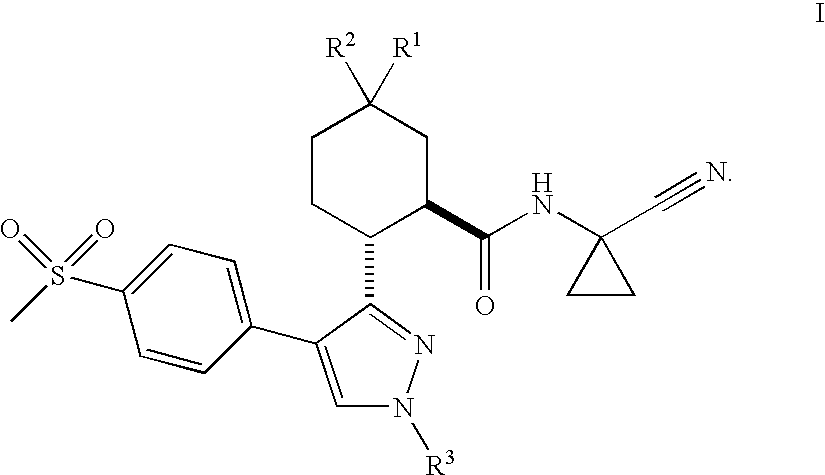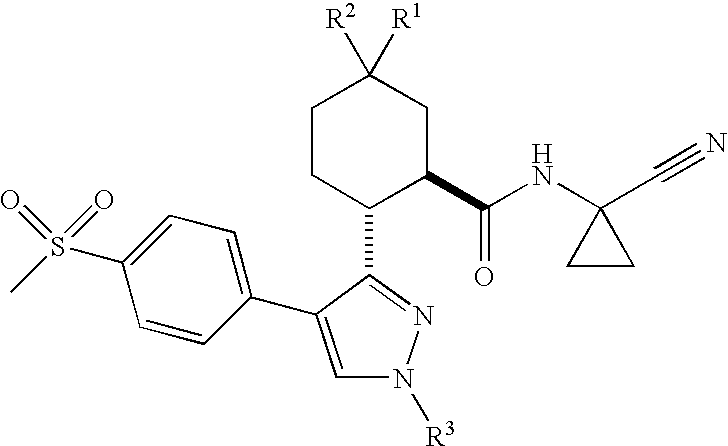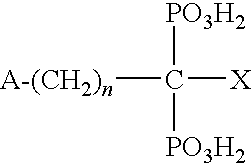Cathepsin cysteine protease inhibitors
a cathepsin cysteine protease and protease inhibitor technology, applied in the field of cathepsin cysteine protease inhibitors, can solve the problems of high risk of fracture, large segment of the older population already has low bone density, morbidity and mortality in the elderly population, etc., and achieve the effect of treating and/or preventing cathepsin dependent conditions
- Summary
- Abstract
- Description
- Claims
- Application Information
AI Technical Summary
Benefits of technology
Problems solved by technology
Method used
Image
Examples
example 1
(1R,2R)-N-(1-Cyanocyclopropyl)-5,5-difluoro-2-[4-[4-(methylsulfonyl)phenyl]-1-(2,2,2-trifluoroethyl)-1H-pyrazol-3-yl]cyclohexanecarboxamide
[0129]
[0130]Diisopropylethylamine (51 mL, 290 mmol) was added slowly to a mechanically stirred, 0° C. slurry composed of {2-[(4R)-4-benzyl-2-oxo-1,3-oxazolidin-3-yl]-2-oxoethyl}phosphonate (94.8 g, 267 mmol; see Shapiro, G; Chengzhi, C. Tetrahedron Lett. 1992, 33, 2447) and dry lithium chloride (12.5 g, 280 mmol) in acetonitrile (260 mL). After stirring for 10 min, a solution of 2-benzyloxyacetaldehyde (40.0 g, 267 mmol) in acetonitrile (20 mL) was added dropwise over 10 min. The cooling bath was then removed and the reaction mixture was stirred at rt for 12 h before being partitioned between ether and water and the layers separated The aqueous phase was extracted with additional ether and the combined organic phases (700 mL total) were stirred at rt with 2M HCl (350 mL) for 1 h. The organic phase was then washed with saturated NaCl and NaHCO3 aq...
example 2
(1R,2R)-N-(1-Cyanocyclopropyl)-5,5-dichloro-2-[4-[4-(methylsulfonyl)phenyl]-1-(2,2,2-trifluoroethyl)-1H-pyrazol-3-yl]cyclohexanecarboxamide
[0144]
[0145]Trimethylsilyl trifluoromethanesulfonate (2.5 mL) was added dropwise to a 0° C. solution of (4R)-4-benzyl-3-({(1R,2R)-2-[(benzyloxy)methyl]-4-oxocyclohexyl}carbonyl)-1,3-oxazolidin-2-one (57.89 g, 138 mmol) and 1,2-bis-(trimethylsilyloxy)ethane (35.4 g, 172 mmol) in CH2Cl2 (400 mL) followed by stirring at rt for 4 h. Triethylamine (3 mL) was then added at 0° C. and the mixture was washed with saturated aqueous NaHCO3 solution and dried over Na2SO4. Concentration in vacuo gave (4R)-4-benzyl-3-({(7R,8R)-7-[(benzyloxy)methyl]-1,4-dioxaspiro[4.5]dec-8-yl}carbonyl)-1,3-oxazolidin-2-one as a thick, tan colored syrup. 1H NMR (500 MHz, d6-acetone) δ 7.36-7.22 (10H, m), 4.48 (1H, m), 4.42 (2H, s), 4.11 (1H, dd, J= 3.1, 8.9 Hz), 3.97 (4H, m), 3.94-3.90 (1H, t, J= 9.0 Hz), 3.67 (1H, m), 3.44-3.38 (2H, m), 3.09 (1H, dd, J= 3.3, 13.5 Hz), 2.92 (1H...
example 3
(1R,2R)-N-(1-cyanocyclopropyl)-5,5-difluoro-2-[4-[4-(methylsulfonyl)phenyl]-1-methyl-1H-pyrazol-3-yl]cyclohexanecarboxamide
[0149]
[0150]A solution of N-(cyanomethyl)-5,5-difluoro-2-{1-methyl-3-[4-(methylthio)phenyl]-1H-pyrazol-4-yl}cyclohexanecarboxamide (see example 4 in WO 2005 / 000800) (795 mg, 1.84 mmol) in CH2Cl2 (10 mL) was treated at 0° C. with purified m-CPBA (760 mg, 4.40 mmol) with stirring at this temperature for 30 min. Dimethyl sulphide was added to quench the excess m-CPBA and the mixture was partitioned between ethyl acetate and saturated aqueous sodium bicarbonate solution. The organic phase was dried (Na2SO4) and concentrated and the residue was purified by flash chromatography on silica to give to title compound as a colorless powder. 1H NMR (500 MHz, acetone d6): δ 7.92 (2H, d, J=8.5 Hz), 7.80 (1H, s), 7.77 (1H, s), 7.72 (2H, d, J= 8.5 Hz), 3.88 (3H, s), 3.28 (1H, m), 3.14 (3H, s), 3.03 (1H, m), 2.20 (1H, m), 2.10-1.90 (4H, m), 1.80 (1H, m), 1.35 (1H, m), 1.30 (1H, ...
PUM
| Property | Measurement | Unit |
|---|---|---|
| active weight | aaaaa | aaaaa |
| volume | aaaaa | aaaaa |
| pH | aaaaa | aaaaa |
Abstract
Description
Claims
Application Information
 Login to View More
Login to View More - R&D
- Intellectual Property
- Life Sciences
- Materials
- Tech Scout
- Unparalleled Data Quality
- Higher Quality Content
- 60% Fewer Hallucinations
Browse by: Latest US Patents, China's latest patents, Technical Efficacy Thesaurus, Application Domain, Technology Topic, Popular Technical Reports.
© 2025 PatSnap. All rights reserved.Legal|Privacy policy|Modern Slavery Act Transparency Statement|Sitemap|About US| Contact US: help@patsnap.com



